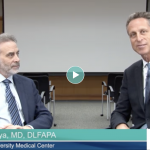Biological Theory of Panic Disorder (Recurrent Panic Attacks)
The prevailing theory of panic disorder states that there are two types of panic attacks, non-phobic spontaneous panic and triggered panic attacks. Nonphobic panic attacks are thought to be the result of abnormal, over- sensitivity of a brain alarm system whose function is to detect early signs of suffocation. This theory is called the suffocation alarm theory. The cardinal symptoms of nonphobic panic are respiratory: shortness of breath, chest discomfort, palpitations and choking or suffocation sensations.
Normally, carbon dioxide, the waste product of respiration, is exhaled from the lungs. In the event of suffocation, the theory suggests that levels of CO2 in the blood, and particularly the brain, rise. Neurons in the solitary nucleus of the brain stem, which are constantly sampling the blood in the brain for levels of carbon dioxide (CO2), become activated about two minutes after an actual or misperceived drop in CO2. This causes a deep sigh, and sensations of smothering (respiratory distress: ‘Hey, you’re not breathing big fella!’). About one and one half minutes following activation of this phase of the alarm, signals are sent to the locus coeruleus. This nucleus is the “on-switch” for almost all of the norepinephrine containing neurons of the brain. As a result of the activation of this nucleus via the solitary nucleus, the second wave of symptoms of panic occur, involving the non-respiratory systems listed above (fight/flight response:’You better act now if you want to live!’) as well as compensation mechanisms in the respiratory system itself (hyperventilation: ‘Pick up the breathing pace, big guy!’). Thus the panic itself is a time limited episode of short (about 4 minutes) duration. Nonphobic panic will occur whenever CO2 levels build up. This usually occurs when respiration slows or CO2 builds up due to exercise. Thus spontaneous nonphobic panic will occur during sleep, as one falls asleep, or during relaxation training, because respiration has slowed allowing CO2 levels to rise. This triggers the overly sensitive suffocation alarm system (solitary nucleus). Patients with this type of panic chronically hyperventilate and sigh, keeping the levels of CO2 low, as a way of preventing sensations of respiratory distress and suffocation. Interestingly, women are more vulnerable to panic attacks premenstrually and just after childbirth. These are both times when the levels of progesterone drop suddenly. Since progesterone decreases the levels of CO2 in the brain by increasing respiratory rate, the loss of progesterone at these points in time would lead to increased CO2, and more vulnerability to panic.
The second type of panic, trigger induced or phobic panic, is the more common type, and is fear induced. It is manifested primarily by symptoms of pounding heart (palpitations), sweating, and trembling (remember that nonphobic panic starts with a subjective sense of suffocation or breathlessness). In this type of panic the locus ceruleus is activated by a real situation of perceived (thought) threat of death or separation. Sometimes it can be triggered by an unconscious awareness of a cue that is linked to a previously dangerous situation. For example, a person who was raped at a young age may have repressed the memory. When a cue which was noticed and associated with the rape activates the amygdala (rage/fear/sex) nucleus of the brain, it activates the locus ceruleus before the person even is conscious of why she/he is feeling that way! The locus ceruleus can be activated by the threat of separation from the group, an individual one is emotionally or physically dependent on, or life itself. This separation alarm triggers the flight or fight response with release of noradrenalin (more commonly called nor epinephrine) in the brain and adrenalin (epinephrine) in the body. According to Donald Klein, fear induced panic activates the stress response system (the hypothalamic pituitary hormonal axis) immediately.
Clinical Differentiation of Panic Subtypes
In treating patients with panic attacks, the clinician should ask questions aimed at differentiating the type of panic attacks which the patient suffers from. The table will assist you in that process. Ask about the cognitions associated with the panic. Is it phobic? Does the panic wake you from sleep? Does it occur as you are falling asleep or relaxing? When it started, were you premenstrual, post-partum, or just weaning your child, (when progesterone levels are falling)? Have their been recent separations, losses which might activate the separation alarm? If a very careful history indicates that there are no triggers (thoughts or situations) just before the episode panic itself, or associated with the onset of the panics, and if the early symptoms seem associated with relaxation and respiratory symptoms, then it is biologically based and the cause should be investigated thoroughly.
Clinical Implications
The possibility of two types of panic attacks implies that treatment must be tailored to the type of panic. Also, the phase of the disorder must be considered since over time complications such as anticipatory anxiety, agoraphobia, substance abuse, or depression may have developed.




